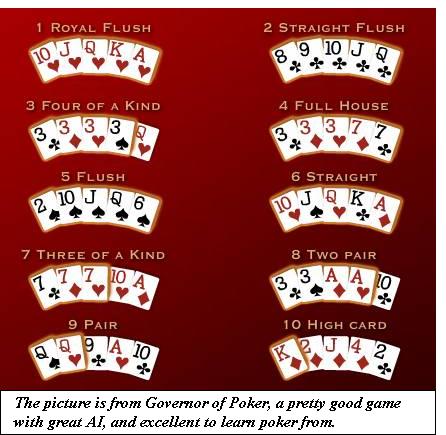Texas Hold ‘Em
A small disclaimer before I begin this article. Gambling with money is wrong, especially if you are not the one earning it. This article examines Texas Hold ‘em poker from the point of view of probability, statistics and behavioral finance. It examines poker as a game of skill, not of luck, and nowhere in the article will you find encouragement to play poker for money.
Nowhere will you find a game which illustrates the concepts of probability, variance and human risk-taking behavior as poker. Texas Hold ‘em is by far the most popular variant of poker played, especially since the World Series Poker Tournament started screening on late night television in the USA and UK, with the winner of the no-limit high stakes game earning more than $9 million. It is also considered the variant with most application of strategy, since there are four rounds of betting and no limits on the amount one can bet (in the no-limit variation).
It would take more words than I have in this article to explain the rules of Texas Hold ‘em completely. In short, you get two cards of your own, and five community cards. There are four rounds of betting, one immediately after you get your two cards (the pre-flop round), one after three community cards are shown (the flop), one after the fourth (the turn) and one after the fifth and final card is revealed (the river). One is supposed to form a hand of the best five cards out of these seven. The hands, in order of strength are illustrated below.
So, a full house would beat a straight, and so on. The above order is the same as the probability of getting a particular hand. The rarest hand is a royal flush, a straight is less rare, while every hand has a high card. If two people have the same kind of hand, say a flush, the Ace high flush would beat the King high flush and so on. If two people have the same pair, two pair or triple, it is the next higher card (called a kicker) which is the decider (a Queen kicker would defeat a Nine kicker). The winner of the hand gets all the money that has been bet (called the pot).In each round of betting, if you want to stay in the game, you must bet. This bet must at least equal the bet of the person who has bet before you. Or you could raise, forcing everyone at the table to match your bet if they want to stay in the game. If you don’t want to bet, you fold, losing all the money you have put in thus far.
With that short (and decidedly insufficient) introduction, let’s jump right in to why poker is the best card game ever. Each hand that you get has a certain probability of being the winning hand, and the decision whether to fold the hand, call or raise, is highly dependent on this (unless of course, you want to bluff!). Let’s say you calculate your chances of winning the hand at 25%. You would not make a bet which would have a negative expected return. In other words, if the total money in the pot is Rs. 300, you should not look to make a bet of more than Rs. 100 (Expected value of return = 25% x 300 + 75% x -100 = 0. This is the probability of winning multiplied by what you stand to win plus the probability of losing multiplied by what you stand to lose. Your prior bets in the pot of Rs. 300 don’t count in this, as it is a sunk cost).
So how does one calculate the probability of winning the hand? Let’s consider a simple situation. You have the King and Nine of diamonds. The flop comes out Ace of diamonds, Three of diamonds and Seven of Clubs. You have only one opponent who goes all-in (he bets all his money, so there will be no rounds of betting after the fourth and fifth cards are revealed, should you choose to match his bet now). You are reasonably sure that he has an Ace, thereby giving him an Ace pair. So what should the fourth and fifth (turn and river) cards be, in order for you to win?
- A diamond on the turn OR river or both would give you a flush (you would have the highest possible flush since you have the King of diamonds and the Ace of diamonds is a community card)
- You get two Kings on the turn and river, giving you a triple
- You get two Nines on the turn and river, giving you a triple
- You get a King and Nine giving you two-pair.
Note that just one King would be insufficient, as your King pair would be beaten by the Ace pair. Of the four scenarios, your best chance is Number 1, that you get a diamond card on the turn or river. We’ll ignore the other three for our calculations (which have a very low probability of occurrence anyway).
The probability of getting a diamond on the turn or river = 1 – The probability of NOT getting a diamond on the turn AND river. This is equal to 1 – 38/47*37/46 which is approximately 35% (You have seen five cards out of 52, leaving 47. Four of the five are diamonds. So there are nine diamonds left, at least one of which must come in the next two cards). So for a pot of Rs. 100, you should not bet more than Rs. 53.84 (100 x 65%/35%).
The situation gets more complicated if your opponent has not gone all-in, i.e. he may bet again after the fourth card. This is important because, if your fourth card is not a diamond, your chances of getting a flush on the fifth card reduce considerably to less than 20% (9 cards out of 46 would get you a flush).So you may have to guess how much he may bet then, which would influence how much you are willing to bet now. It’s a pretty dynamic programming problem.
So why should you bet according to the expected value? This is assuming you are rational. But behavioral finance tells us something very interesting. Humans are in general irrational, so a person may not make a bet even if the expected return is positive. This is because a profit of a certain amount causes less (for want of a better word) joy to him than the amount of sadness the loss of the same amount would bring.
Of course, poker is not purely about mathematics. How well you can read your opponent is perhaps just as important. This is why the infamous poker face has emerged and professionals wear sunglasses to hide the expression in their eyes. (A friend of mine was telling me about a game, when she could accurately predict when her opponent had good cards. He just couldn’t stop smiling whenever he looked at them!) And you can tell a lot about what hand a person has by how and when he/she bets. This is why it is necessary to introduce some randomness into your play, and be less predictable.
A lot of people say that poker is all about luck, but all poker players out there will swear to you that it’s not true. Let’s say you play poker every day for five years, and on an average, you’ve made a 30% profit on your initial investment (buy-in) each day. On a good day you may double your money, and on a bad day, you may lose it all. This is where luck comes in. Luck is but short term variance in your performance, and the law of large numbers will tell you that there’s no such thing as long term variance. If you have played poker for a long time, and have made a profit on an average, there is a statistically insignificant chance that this is due to luck. In other words, you can attribute this to skill.
Poker is unforgivingly fair in that everyone has their share of negative variance (bad luck), but everyone has their share of lucky breaks as well, and the winners in the long run are those who have grasped the concepts of the game in its entirety. Everyone has a bad day some time or the other, and how you play on a bad day to limit your losses is just as important as how much you can maximize your gains on a really good one. Poker, in short, is where you alternate between the thrill of victory and the agony of defeat, when you can move from being completely blindsided by your opponents to completely dominating them. Poker is full of ups and downs, and if you play long enough, you learn to love every moment of it.
Siddarth Madhav, an alumnus of the 2007 batch, was a senior member of InsIghT. He is currently in his second year at IIM Bangalore.
Volume XI

